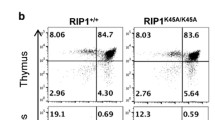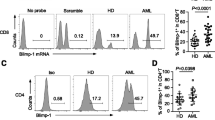Abstract
The BAF57 subunit, an indispensable member of the BAF complex, is functionally implicated in apoptosis, cell cycle, and T cell development through chromosomal remodeling. However, the precise roles of BAF57 in the T cell receptor (TcR)-mediated signaling pathway have not been elucidated. In this study, a nucleus-transducible form of BAF57, absent the proline-rich and HMG domains (ntBAF57-ΔPH), was generated to interfere with the interaction between BAF57 and its binding protein, BAF155. ntBAF57-ΔPH was effectively delivered into mouse CD4+ T cells in a dose- and time-dependent manner, without cellular toxicity. Inhibition of T cell activation by ntBAF57-ΔPH was mediated by its disruption of the interaction between BAF155 and BAF57, leading to the degradation of endogenous BAF57 and BAF155. This phenomenon led to alterations in gene expression similar to those associated with Ciclosporin A treatment. In vivo administration of ntBAF57-ΔPH enhanced survival rate of sepsis-induced mice and reduced the LPS-induced secretion of pro-inflammatory cytokines and the expression of endogenous BAF57. These results reveal a novel function of BAF57 as an essential regulator of T cell activation. ntBAF57-ΔPH represents a novel immune-suppressive drug candidate with potential uses in the treatment of autoimmunity and graft rejection.




Similar content being viewed by others
Abbreviations
- ntBAF57-ΔPH:
-
Nucleus-transducible BAF57-without proline-rich and HMG domain
References
Wurster AL, Pazin MJ. ATP-dependent chromatin remodeling in T cells. Biochem Cell Biol. 2011;90(1):1–13.
Zhao K, Wang W, Rando OJ, Xue Y, Swiderek K, Kuo A, et al. Rapid and phosphoinositol-dependent binding of the SWI/SNF-like BAF complex to chromatin after T lymphocyte receptor signaling. Cell. 1998;95(5):625–36.
Gebuhr TC, Kovalev GI, Bultman S, Godfrey V, Su L, Magnuson T. The role of Brg1, a catalytic subunit of mammalian chromatin-remodeling complexes, in T cell development. J Exp Med. 2003;198(12):1937–49.
Chi TH, Wan M, Zhao K, Taniuchi I, Chen L, Littman DR, et al. Reciprocal regulation of CD4/CD8 expression by SWI/SNF-like BAF complexes. Nature. 2002;418(6894):195–99.
Brettingham-Moore KH, Sprod O, Chen X, Oakford P, Shannon MF, Holloway AF. Determinants of a transcriptionally competent environment at the GM-CSF promoter. Nucleic Acids Res. 2008;36(8):2639–53.
Wurster AL, Precht P, Pazin MJ. NF-κB and BRG1 bind a distal regulatory element in the IL-3/GM-CSF locus. Mol Immunol. 2011;48(15):2178–88.
Jeong SM, Lee C, Lee SK, Kim J, Seong RH. The SWI/SNF chromatin-remodeling complex modulates peripheral T cell activation and proliferation by controlling AP-1 expression. J Biol Chem. 2010;285(4):2340–50.
De S, Wurster AL, Precht P, Wood WH, Becker KG, Pazin MJ. Dynamic BRG1 recruitment during T helper differentiation and activation reveals distal regulatory elements. Mol Cell Biol. 2011;31(7):1512–27.
Chen J, Archer TK. Regulating SWI/SNF subunit levels via protein–protein interactions and proteasomal degradation: BAF155 and BAF170 limit expression of BAF57. Mol Cell Biol. 2005;25(20):9016–27.
Choi J-M, Ahn M-H, Chae W-J, Jung Y-G, Park J-C, Song H-M, et al. Intranasal delivery of the cytoplasmic domain of CTLA-4 using a novel protein transduction domain prevents allergic inflammation. Nat Med. 2006;12(5):574–9.
Park T-Y, Park S-D, Cho J-Y, Moon J-S, Kim N-Y, Park K, et al. RORγt-specific transcriptional interactomic inhibition suppresses autoimmunity associated with TH17 cells. Proc Natl Acad Sci USA. 2014;111(52):18673–78.
Northrop JP, Ho SN, Chen L, Thomas DJ, Timmerman LA, Nolan GP, et al. NF-AT components define a family of transcription factors targeted in T-cell activation. Nature. 1994;369(6480):497–502.
Baldwin AS Jr. The NF-κB and IκB proteins: new discoveries and insights. Annu Rev Immunol. 1996;14(1):649–81.
Rincon M, Flavell R. AP-1 transcriptional activity requires both T-cell receptor-mediated and co-stimulatory signals in primary T lymphocytes. EMBO J. 1994;13(18):4370–81.
Reynolds JM, Martinez GJ, Chung Y, Dong C. Toll-like receptor 4 signaling in T cells promotes autoimmune inflammation. Proc Natl Acad Sci USA. 2012;109(32):13064–69.
Acknowledgements
This work was partially supported by the research grant from Good T Cells; the National Research Foundation of Korea (NRF) grant funded by the Korea government (MSIT) (No. NRF-2017R1A2A1A17069807); Global Research Laboratory (GRL) Program through the National Research Foundation of Korea (NRF) funded by the Ministry of Science and ICT (NRF-2016K1A1A2912755). In addition, this work was supported in part by the Yonsei University Future-leading Research Initiative of 2015 (RMS2 2017-22-0137). We would like to thank Jee-Sang Yoon for technical assistance.
Author information
Authors and Affiliations
Corresponding author
Ethics declarations
Conflict of interest
The authors declare no conflict of interest.
Electronic supplementary material
Below is the link to the electronic supplementary material.
About this article
Cite this article
Moon, JS., Lee, HJ., Ho, CC. et al. Immuno-suppressive function of nucleus-transducible BAF57-ΔPH in T cell activation via degradation of endogenous BAF57. Int J Hematol 108, 375–383 (2018). https://doi.org/10.1007/s12185-018-2491-6
Received:
Revised:
Accepted:
Published:
Issue Date:
DOI: https://doi.org/10.1007/s12185-018-2491-6




